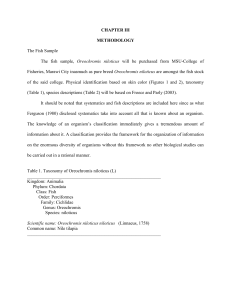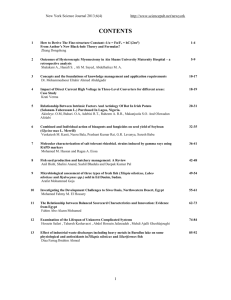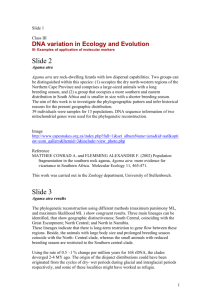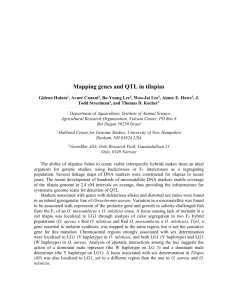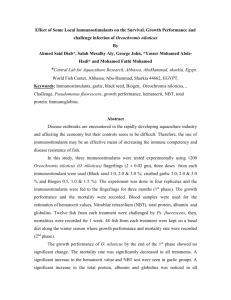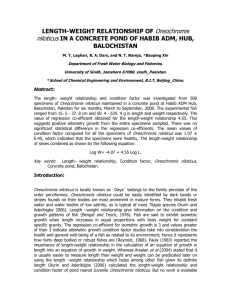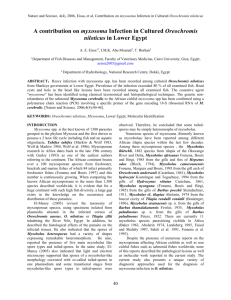Study of the Impacts of Some Parasites on Certain Biological
advertisement
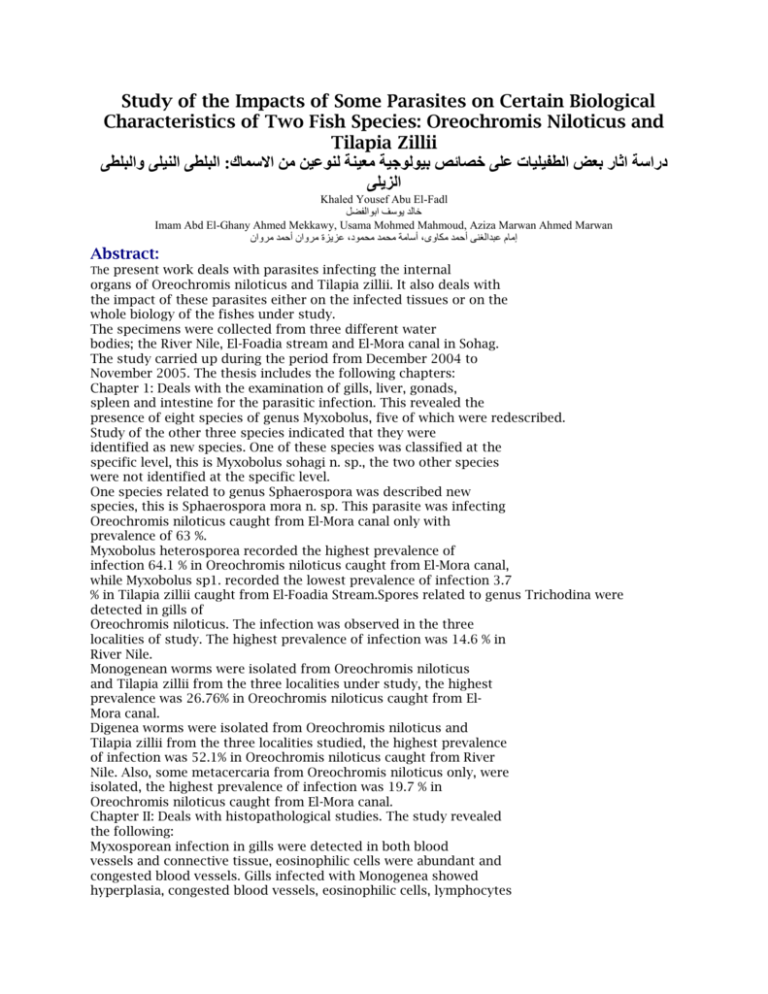
Study of the Impacts of Some Parasites on Certain Biological Characteristics of Two Fish Species: Oreochromis Niloticus and Tilapia Zillii البلطى النيلى والبلطى:دراسة اثار بعض الطفيليات على خصائص بيولوجية معينة لنوعين من االسماك الزيلى Khaled Yousef Abu El-Fadl خالد يوسف ابوالفضل Imam Abd El-Ghany Ahmed Mekkawy, Usama Mohmed Mahmoud, Aziza Marwan Ahmed Marwan عزيزة مروان أحمد مروان، أسامة محمد محمود،إمام عبدالغنى أحمد مكاوى Abstract: The present work deals with parasites infecting the internal organs of Oreochromis niloticus and Tilapia zillii. It also deals with the impact of these parasites either on the infected tissues or on the whole biology of the fishes under study. The specimens were collected from three different water bodies; the River Nile, El-Foadia stream and El-Mora canal in Sohag. The study carried up during the period from December 2004 to November 2005. The thesis includes the following chapters: Chapter 1: Deals with the examination of gills, liver, gonads, spleen and intestine for the parasitic infection. This revealed the presence of eight species of genus Myxobolus, five of which were redescribed. Study of the other three species indicated that they were identified as new species. One of these species was classified at the specific level, this is Myxobolus sohagi n. sp., the two other species were not identified at the specific level. One species related to genus Sphaerospora was described new species, this is Sphaerospora mora n. sp. This parasite was infecting Oreochromis niloticus caught from El-Mora canal only with prevalence of 63 %. Myxobolus heterosporea recorded the highest prevalence of infection 64.1 % in Oreochromis niloticus caught from El-Mora canal, while Myxobolus sp1. recorded the lowest prevalence of infection 3.7 % in Tilapia zillii caught from El-Foadia Stream.Spores related to genus Trichodina were detected in gills of Oreochromis niloticus. The infection was observed in the three localities of study. The highest prevalence of infection was 14.6 % in River Nile. Monogenean worms were isolated from Oreochromis niloticus and Tilapia zillii from the three localities under study, the highest prevalence was 26.76% in Oreochromis niloticus caught from ElMora canal. Digenea worms were isolated from Oreochromis niloticus and Tilapia zillii from the three localities studied, the highest prevalence of infection was 52.1% in Oreochromis niloticus caught from River Nile. Also, some metacercaria from Oreochromis niloticus only, were isolated, the highest prevalence of infection was 19.7 % in Oreochromis niloticus caught from El-Mora canal. Chapter II: Deals with histopathological studies. The study revealed the following: Myxosporean infection in gills were detected in both blood vessels and connective tissue, eosinophilic cells were abundant and congested blood vessels. Gills infected with Monogenea showed hyperplasia, congested blood vessels, eosinophilic cells, lymphocytes and destruction of the lamellar structure. Parasitic infection in the kidney leads to destruction of glomeruli in some cases and congestion of others, also eosinophelic cells and melanomacrophage cells were abundant in the hemopoietic tissue.In the infected liver the following features were observed, pyknosis of the hepatic cells, pancreatic acini were dislocated and melanomacrophage cells were present within the parenchymal tissue. The infected ovary showed the presence of cysts dispersed inside the ovary. The oocytes surrounding the cyst showed degeneration of nuclei, oocystes’s desquamation of the follicular cells, Inflammatory cells were recorded around the cysts. The infected testis exhibits some features such as loss of the regular shape of the tubule, disturbance of the normal arrangement of the seminiferous tubule cells, damage of some cells, complete degeneration of some others and loss of great number of spermatides. Chapter III Deals with impacts of parasites on certain biological characteristics of Oreochromis niloticus and Tilapia zillii under investigation. The study revealed the following: Prevalence, intensity and abundance of parasites (protozoa and helminthes) in Oreochromis niloticus and Tilapia zillii from El–Mora canal and El–Foadia stream were higher than those of the River Nile (the control). Protozoa prevalence, intensity and abundance outnumbered those of helminthes in the three localities studied except for Tilapia zillii of the River Nile. The highest prevalence of protozoans in Oreochromis niloticus and Tilapia zillii was recorded in El Mora canal referring to its polluted nature.The highest percentage of infection by helminthes in Oreochromis niloticus and Tilapia zillii was recorded in the River Nile, the control locality. The degree of infection of Oreochromis niloticus and Tilapia zillii was associated with the localities (P< 0.01) In each locality, the protozoan and helminthes parameters were higher in Oreochromis niloticus than in Tilapia zillii referring to the higher sensitivity of Oreochromis niloticus to parasitism especially in the polluted locality. The infection was higher in kidney, spleen and gills of Oreochromis niloticus in the three localities studied. The infection was higher in stomach, intestine and gills of Tilapia zillii from River Nile, for gills, spleen and kidney from ElFoadia and El-Mora canal. Comparing localities, El-Mora exhibited the highest percentage of gonad infection for both species (39.4 % and 16.67 % for Oreochromis niloticus and Tilapia zillii respectively). Sexual dimorphism in prevalence, intensity and abundance of parasites in Oreochromis niloticus and Tilapia zillii was evident in all localities. In spite of association between sex and both of fish species, locality and type of parasites, there is no special trend to be postulated in relation to pollution.In the River Nile, the total parasites (TP) were significantly correlated with fish size (SL) of Oreochromis niloticus and Tilapia zillii. In El-Foadia stream small fishes of Oreochromis niloticus did not exhibit correlation between fish size and TP whereas a significant correlation was recorded for large fishes. In El-Mora, total parasites increased weakly with small fish size and strongly decreased with increase of large fish size. Total parasites recorded in Tilapia zillii reflect one increased trend with fish size increase. In Tilapia zillii, the total parasites were weakly correlated with body weight (BW) increase in the three localities studied. In Oreochromis niloticus Except for El-Mora Canal, similar results were recorded. Except for the River Nile, the intensity of infection was not significantly correlated with the condition factor of Oreochromis niloticus and Tilapia zillii. The relationships between standard length (SL) and body (BW), Kidney (KW), liver (LW), spleen (SW) and gonad (GW) weights reflect to some extent the impact of parasite intensity infection. The pattern of growth of these infected organs show slight variability in comparison with the non- infected ones. No ovary infection was recorded in the River Nile for both Oreochromis niloticus and Tilapia zillii and in El-Foadia for Tilapia zillii. In El-Mora Canal and El-Foadia stream the infected females had lower fecundity in comparison with the non-infected females of Oreochromis niloticus and Tilapia zillii.
